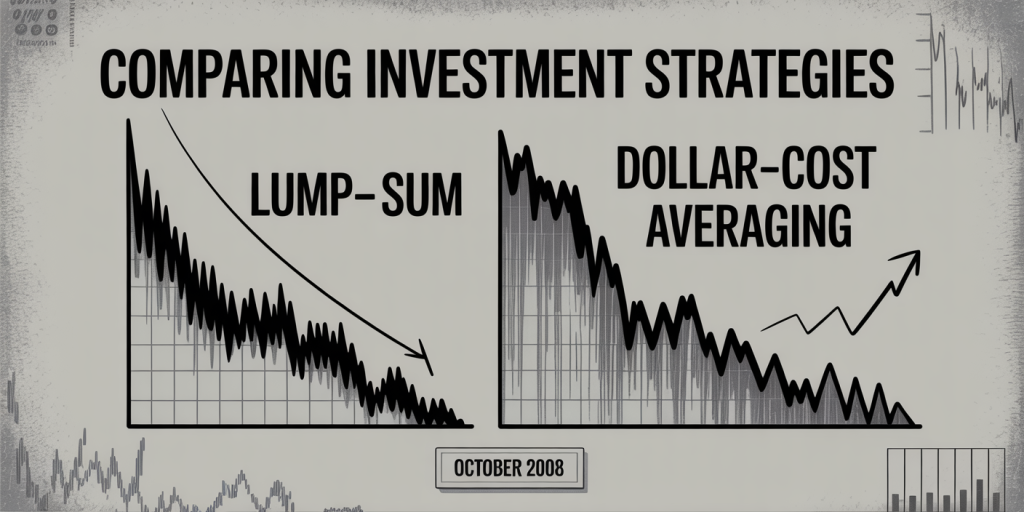How Dollar-Cost Averaging Can Reduce Risk Over Time
Anúncios
In the realm of personal finance and investing, risk management is a critical factor that can significantly influence long-term returns. While markets can be unpredictable and volatile, there are strategies designed to mitigate risk and smooth out investment returns over time. One such method is Dollar-Cost Averaging (DCA). This systematic investment approach aims to reduce the impact of market fluctuations by spreading out purchases over a longer duration. By investing fixed amounts at regular intervals regardless of market conditions, investors can potentially lessen timing risks and maintain a disciplined approach to growing their portfolios.

Dollar-Cost Averaging has gained popularity among both novice and experienced investors due to its straightforward nature and risk-reduction potential. Unlike lump-sum investing, where a single investment is made at one point in time, DCA involves dividing the total investment sum into smaller installments and investing them in stages. This article delves into how this strategy works, compares it with lump-sum investing, explores its risk-reduction capabilities, and provides real-world examples backed by data and statistics.
Anúncios
Understanding Dollar-Cost Averaging: Mechanism and Benefits
Dollar-Cost Averaging is an investment technique where an individual invests a fixed dollar amount into a particular asset consistently over a period, regardless of the asset’s price. For example, an investor might commit to investing $500 every month into an index fund. During months when the asset price is high, fewer shares are purchased; when the price drops, more shares are bought. Over time, this approach tends to reduce the average cost per share.

A key benefit of DCA lies in its attempt to neutralize the risks associated with market timing, which even seasoned investors find challenging. Because it removes emotional decision-making based on short-term market movements, DCA promotes discipline and long-term investing habits. This steady investing rhythm is particularly advantageous during volatile market periods by helping investors avoid large losses from poorly timed lump-sum investments.
Real Case Study: Vanguard 500 Index Fund
Consider the experience of investors in the Vanguard 500 Index Fund during the 2008 financial crisis. Those who invested a lump sum in early 2008 faced significant paper losses by the time the market bottomed in March 2009, losing approximately 37% of their investment value. In contrast, investors who used a DCA approach by investing equal amounts monthly over 12 months during that period experienced a much lower average cost per share and reduced downside exposure. Data from Vanguard indicate that DCA led to approximately 18% less loss on average compared to lump sum investing in such turbulent periods.
Comparing Dollar-Cost Averaging and Lump-Sum Investing
The choice between DCA and lump-sum investing is a common dilemma. To better understand the differences, let’s analyze each strategy’s risk and return attributes based on historical data and market behavior.
| Feature | Dollar-Cost Averaging | Lump-Sum Investing |
|---|---|---|
| Timing Risk | Low – invests over time to reduce timing risk | High – entire capital exposed at one time |
| Potential for Higher Returns | Moderate – may miss gains if market rises steadily | High – immediate exposure captures early gains |
| Psychological Stress | Lower – avoids decision paralysis and emotional investing | Higher – requires market timing confidence |
| Market Volatility Impact | Mitigates impact by averaging costs | High vulnerability to market dips |
| Discipline Encouragement | Promotes systematic investing habits | Requires self-control and market prediction |
Empirical studies, such as those conducted by Dalbar Inc., highlight that investor behavior often leads to poor timing decisions. Lump-sum investors are prone to panic selling or delaying investments during downturns. Dollar-Cost Averaging minimizes these behavioral pitfalls by automating investments over time.

Quantitative Analysis: How Dollar-Cost Averaging Reduces Volatility
Volatility is a major concern for many investors because short-term price swings can significantly affect portfolio values. Dollar-Cost Averaging effectively reduces portfolio volatility by spreading investments across various price points.
A study by Morningstar (2020) analyzed S&P 500 returns over 30 years, comparing lump-sum investments to a 12-month DCA approach. The findings revealed that lump-sum investing outperformed DCA approximately 66% of the time in rising markets. However, during bear markets or volatile conditions, DCA significantly lowered downside risk, reducing the average maximum drawdown by as much as 12%.
By continually buying more shares when prices fall, DCA lowers the average cost basis and cushions against steep portfolio declines. This adaptive purchasing pattern means investors tend to experience less severe losses during downturns, which is crucial for long-term wealth preservation.
Practical Examples: Implementing Dollar-Cost Averaging in Various Assets
Dollar-Cost Averaging is not confined to stocks alone. It can be applied across a spectrum of assets ranging from mutual funds and exchange-traded funds (ETFs) to cryptocurrencies and commodities.
Example 1: Investing in an S&P 500 ETF
Suppose an investor has $12,000 to invest in an S&P 500 ETF. Using a lump sum, the entire $12,000 would be deployed on day one. Alternatively, using DCA, the investor could invest $1,000 each month over 12 months. In a bull market (e.g., 2017, where the S&P 500 grew approximately 19%), lump-sum investing would yield higher returns due to early exposure. In a volatile or declining market (e.g., 2022, when the S&P 500 returned roughly -18%), the DCA investor would benefit from buying shares at lower prices during the year, thus reducing losses.
Example 2: Crypto Market Volatility
Cryptocurrencies like Bitcoin have notoriously high price volatility. Investors who used DCA from 2017 through 2020 saw a more stable growth curve, buying more coins during downturns and fewer during spikes. Data from CoinDesk reveals that a DCA approach averaged about a 30% lower purchase price than investors who bought a lump sum at peak prices.
These practical examples demonstrate that while DCA may sometimes lead to slightly lower returns in steadily rising markets, it consistently reduces the emotional and financial risks associated with volatile or falling markets.
Behavioral Finance: How Dollar-Cost Averaging Supports Investor Psychology
Investor behavior often complicates wealth-building, with emotions such as fear and greed leading to poor timing decisions. Dollar-Cost Averaging can be a psychologically safer strategy because it removes the pressure of trying to time the market perfectly.
Many investors tend to delay investing during market downturns waiting for a “bottom” and rush in during rallies, often leading to purchasing high and selling low. DCA automates investing, encouraging consistent contributions regardless of market sentiment. This discipline counters cognitive biases like loss aversion and panic selling.
Research published in the Journal of Behavioral Finance highlights that systematic investing methods decrease anxiety and improve long-term adherence to investment plans. The simplicity of DCA appeals to novice investors who might otherwise be overwhelmed by market complexities.
Future Perspectives: The Evolving Role of Dollar-Cost Averaging in Modern Investing
As investing technologies evolve and financial markets grow increasingly complex, Dollar-Cost Averaging remains a timeless technique with growing relevance. Algorithm-driven robo-advisors and automated investment platforms commonly incorporate DCA principles, allowing investors to seamlessly invest fixed sums at regular intervals without additional effort.
Moreover, with the rise of fractional shares and zero-commission trading, executing DCA strategies has become more accessible and cost-effective than ever. Investors can start with minimal amounts, continuously build exposure, and avoid the pitfalls of market timing.
Looking ahead, the integration of artificial intelligence and machine learning may refine dollar-cost averaging by optimizing the pace of investments based on market indicators, risk tolerance, and personal savings rates. While these advancements may modify DCA execution, the core principle of gradual, systematic investment will likely remain a foundational risk reduction strategy.
In conclusion, Dollar-Cost Averaging offers a pragmatic solution to one of the toughest challenges in investing: mitigating risk over time. Through consistent contributions and avoidance of timing hazards, DCA bridges the gap between disciplined investing and behavioral pitfalls. Supported by historical data and behavioral science, its effectiveness spans various asset classes and market conditions. As financial ecosystems continue to evolve, DCA stands poised to retain its significance in the investor toolkit for years to come.
